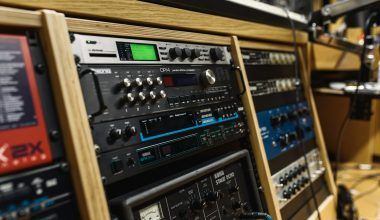Have you ever stepped into a recording studio and felt amazed by all the shiny equipment? If you look closely, you’ll notice one device that stands out in every setup—the microphone. It’s not just a piece of gear; it’s the heart and soul of capturing sound. Whether you’re recording a podcast, laying down vocals for a song, or creating voiceovers for videos, the microphone is your most important ally. Let’s dive deep into why this humble device plays such a critical role in the recording studio.
Why the Right Microphone Matters
When it comes to recording, the microphone you choose can make or break the quality of your sound. A great microphone doesn’t just capture audio; it captures emotion, detail, and nuance. Think about your favorite song. The warmth of the singer’s voice, the crispness of the instruments—all of that magic starts with the microphone.
For example, a condenser microphone is ideal for studio settings. It picks up subtle details that other types of microphones might miss. This is why many professional recording studios rely on them for vocals and acoustic instruments. On the other hand, dynamic microphones are more rugged and better suited for louder environments, like live performances or recording amplified instruments.
Understanding How Microphones Work
Before we get into choosing the right microphone for your recording studio, it’s helpful to understand how they work. Simply put, a microphone converts sound waves into electrical signals. These signals can then be amplified, recorded, or processed.
There are different types of microphones, and each operates in its unique way:
- Dynamic Microphones: These are sturdy and versatile. They use a diaphragm that vibrates when hit by sound waves, creating an electrical signal.
- Condenser Microphones: Known for their sensitivity, these microphones use a capacitor to capture sound. They’re perfect for detailed recordings but usually require external power, like phantom power.
- Ribbon Microphones: These are prized for their warm, vintage sound. They use a thin ribbon of metal to capture vibrations and are great for recording vocals and string instruments.
Choosing the Right Microphone for Your Needs
Selecting the right microphone depends on what you plan to record. Are you a singer? A podcaster? A musician? Each use case has specific requirements.
For Vocals
When recording vocals, clarity is key. Most professionals swear by condenser microphones because of their ability to capture intricate details. Brands like Neumann, Audio-Technica, and Rode offer excellent options for vocal recording. Placement is also critical; keeping the microphone at the right distance ensures that your voice comes through clearly without unwanted distortion.
For Instruments
Different instruments require different microphones. For example, a dynamic microphone like the Shure SM57 is a classic choice for recording electric guitars or drums. Meanwhile, a condenser microphone works wonders for acoustic guitars, pianos, or violins. Ribbon microphones can add a touch of vintage warmth to string instruments, giving them a unique, rich sound.
For Podcasts and Voiceovers
Podcasts and voiceovers need microphones that highlight the human voice while minimizing background noise. A USB condenser microphone is often a good starting point for beginners. If you’re setting up a professional studio, consider an XLR condenser microphone for better sound quality.
Setting Up Your Microphone in the Studio
Even the best microphone won’t perform well without proper setup. Here are some tips to get it right:
- Use a Pop Filter: A pop filter helps reduce plosive sounds (like “p” and “b”) that can cause distortion.
- Position Correctly: The angle and distance between the microphone and the sound source matter. Experiment to find the sweet spot.
- Reduce Background Noise: Use soundproofing materials to minimize unwanted noise. This ensures that your microphone captures only the intended sound.
Microphone Accessories You Need
To get the best performance from your microphone, consider investing in these essential accessories:
- Shock Mounts: These help isolate the microphone from vibrations.
- Stands and Booms: A sturdy stand ensures that your microphone stays in place during recording.
- Cables: High-quality XLR cables maintain the integrity of your sound signal.
Taking Care of Your Microphone
A microphone is an investment, so taking care of it is crucial. Always store it in a safe, dry place when not in use. Clean it regularly to remove dust and moisture. If you’re using a condenser microphone, handle it gently, as its internal components are delicate.
Exploring Microphone Brands
With so many brands and models available, choosing a microphone can feel overwhelming. Here are a few trusted names in the industry:
- Shure: Known for durable and versatile microphones.
- Neumann: Renowned for high-end studio microphones.
- Rode: A favorite among podcasters and content creators.
- Audio-Technica: Offers a range of microphones for different budgets and needs.
Microphones and Recording Techniques
The type of microphone you use also influences your recording technique. For instance, when using a condenser microphone, you might want to record in a soundproof room to avoid capturing unwanted noise. Dynamic microphones, on the other hand, are more forgiving and can be used in less controlled environments.
Experimentation is key. Try different microphones and techniques to see what works best for your style and sound.
Final Thoughts
A microphone is much more than a piece of equipment in a recording studio. It’s the bridge between your creative ideas and the final product. Choosing the right microphone, setting it up correctly, and maintaining it well can elevate your recordings from good to extraordinary. So, the next time you step into a recording studio, take a moment to appreciate the microphone—your best friend in capturing sound.
Remember, the microphone is just the start. Your creativity, technique, and passion bring it all to life. Happy recording!
Related Articles:
For further reading, explore these related articles:
- SZA’s Grammy Awards Journey: A Heartwarming Story of Hard Work and Talent
- Xin Kpop Group: The Rising Stars You Need to Know
For additional resources on music marketing and distribution, visit DMT RECORDS PRIVATE LIMITED






